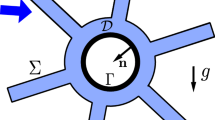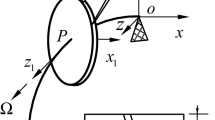Abstract
Mistuning can produce a considerable increase of the vibratory forced response of the blades compared with that of the tuned bladed disk. This situation can lead to high cycle fatigue failure, and, therefore, it is of crucial importance for the prediction of the safe operation limit of the bladed disk. Nonlinear friction forces determine the final vibration amplitude of the blades, and, because of mistuning, the complete bladed disk has to be considered, increasing considerably the difficulty of the problem. For this reason, we consider the application of asymptotic multiple scale techniques to derive simplified models that give the final vibration states at a very low CPU cost. This asymptotic method is based on the idea that all significant effects (forcing, nonlinear friction damping, and mistuning) produce, in most practical situations, just small corrections of the tuned blade elastic oscillation. These small effects develop in a much longer time scale than that associated with the natural elastic frequency of the tuned system. The reduced models produced by this asymptotic methodology retain only the slow time dynamics, filtering out the fast scale oscillation. In this paper, the bladed disk is described using a mass-spring system with nonlinear friction and with an external forcing acting on a blade-dominated modal family where all modes have very similar vibration frequencies. The derivation of the asymptotic model from the mass-spring system is explained in detail, and validated against the results from the original mass-spring model.















Similar content being viewed by others
References
Bender, C.M., Orszag, S.A.: Advanced Mathematical Methods for Scientists and Engineers: I: Asymptotic Methods and Perturbation Theory. Springer, New York (1999). https://doi.org/10.1007/978-1-4757-3069-2
Corral, R., Gallardo, J.M.: A methodology for the vibration amplitude prediction of self-excited rotors based on dimensional analysis. In: Proceedings of ASME Turbo Expo 2016: Turbomachinery Technical Conference and Exposition, ASME, GT2006-90668, pp 1101–1113 (2016) https://doi.org/10.1115/GT2006-90668
Corral, R., Beloki, J., Calza, P., Elliott, R.: Flutter generation and control using mistuning in a turbine rotating rig. AIAA J. 57(2), 782–795 (2019). https://doi.org/10.2514/1.J056943
Kevorkian, J., Cole, J.: Multiple Scale and Singular Perturbation Methods, Applied Mathematical Sciences, vol 114. Springer, New York (1996). https://doi.org/10.1007/978-1-4612-3968-0
Krack, M., Salles, L., Thouverez, F.: Vibration prediction of bladed disks coupled by friction joints. Arch. Comput. Methods Eng. 24, 589–636 (2017). https://doi.org/10.1007/s11831-016-9183-2
Martel, C., Corral, R.: Asymptotic description of maximum mistuning amplification of bladed disk forced response. J. Eng. Gas Turbin. Power 131(2), 022506 (2009). https://doi.org/10.1115/1.2968868
Martel, C., Martin, J.A.: Asymptotic description of forced response vibration saturation by friction forces. J. Eng. Gas Turbines Power 142(2), 011022:1–8 (2020). https://doi.org/10.1115/1.4044934
Martel, C., Corral, R., Ivaturi, R.: Flutter amplitude saturation by nonlinear friction forces: Reduced model verification. J. Turbomach. 137(4), 041004:1–8 (2014). https://doi.org/10.1115/1.4028443
Olofsson, U.: Cyclic microslip under unlubricated conditions. Tribol. Int. 28(4), 207–217 (1995). https://doi.org/10.1016/0301-679X28942900001-7
Petrov, E.P., Ewins, D.J.: Analytical formulation of friction interface elements for analysis of nonlinear multi-harmonic vibrations of bladed disks. J. Turbomach. 125(2), 364–371 (2003). https://doi.org/10.1115/1.1539868
Petrov, E.P., Ewins, D.J.: State-of-the-art dynamic analysis for non-linear gas turbine structures. Proc. Inst. Mech. Eng. Part G: J. Aerosp. Eng. 218(3), 199–211 (2004). https://doi.org/10.1243/0954410041872906
Yang, B., Menq, C.: Characterization of 3d contact kinematics and prediction of resonant response of structures having a 3d frictional constraint. J. Sound Vib. 217(5), 909–925 (1998). https://doi.org/10.1006/jsvi.1998.1802
Yang, B., Chu, M., Menq, C.: Stick-slip-separation analysis and non-linear stiffnes and damping characterization of friction contacts having variable normal load. J. Sound Vib. 210(4), 461–481 (1998). https://doi.org/10.1006/jsvi.1997.1305
Acknowledgements
This work has been supported by the Spanish Ministerio de Ciencia, Innovación y Universidades under Grant DPI2017-84700-R.
Author information
Authors and Affiliations
Corresponding author
Ethics declarations
Conflict of interest
The authors declare that they have no conflict of interest.
Additional information
Publisher's Note
Springer Nature remains neutral with regard to jurisdictional claims in published maps and institutional affiliations.
Rights and permissions
About this article
Cite this article
Martín, J.A., Martel, C. Simplification of the forced response of mistuned bladed disks using multiple scales techniques. Nonlinear Dyn 104, 2037–2049 (2021). https://doi.org/10.1007/s11071-021-06397-0
Received:
Accepted:
Published:
Issue Date:
DOI: https://doi.org/10.1007/s11071-021-06397-0




